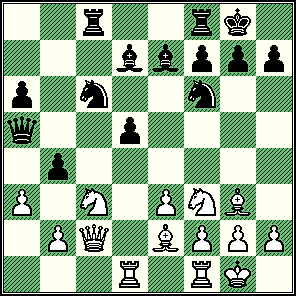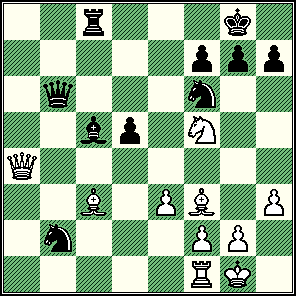GM Joel Lautier (2672) -
GM Anatoli Vaisser (2576)
|
|
|
(A bonus D/L game for September, 2005. {"Game of The Month"
column.} Source: TWIC
# 563.)
1.d4 e6; 2.c4 d5; 3.Nc3 Be7; 4.Nf3 Nf6;
5.Bf4!?,
Korchnoi, among others, liked to use this move on occasion.
(I think it is a regular part of GM Joel Lautier's repertoire.)
For a complete breakdown of this opening, see my "Game of The Month" for October, 2004.
[ Standard here is: 5.Bg5, "+/=" (QGD) [See any good reference work.] ]
5...0-0; 6.e3 c5!?; 7.dxc5! Bxc5; 8.a3!?,
This is good enough for a small advantage for White.
[ For >/= 8.cxd5!, see my column ... and also the following contest:
Peter Leko - Vladimir
Kramnik; The Danneman World's Champ. /
Brissago, SUI / October, 2004.
]
8...Nc6; 9.Qc2 Qa5; 10.Nd2!?,
This is probably (still) good enough for a small edge for White.
[
10.0-0-0;
is the line in MCO. {Modern Chess Openings.}
(And most other reference books as well.)
]
10...Be7; 11.Bg3!?,
A very restrained move ... that is also a 'book' response here.
[ The most popular is:
11.Rd1,
"+/=" when White has a small edge.
(GM B. Gelfand - GM B. Gelfand; ICT / Super-Master(s)
Dos Hermanas, ESP; 1999.)
*****************************************************
The line of:
11.Nb3 Qb6; 12.cxd5,
"+/=" {D?}
also looks good for White.
(GM S. Lputian - GM R. Vaganian;
ICT / Petrosian Memorial, 1994.)
{Both of the above games were eventually drawn.} ]
11...Bd7; 12.Rd1, (center)
This is (also) good enough for a solid edge for White ... the most popular move, according to the database, is 12.Be2.
[
Another possibility is:
(>/=) 12.Be2 Rfc8; 13.0-0 Qd8;
14.Rad1, "+/="
with a small edge.
GM J. Lautier - GM A. Beliavsky; /
Bundesliga 0102, (12) /
2001. {This game was drawn.} ]
12...Rac8; 13.Be2 a6N;
Apparently this simple move is a novelty, previous played was the try of: 13...Qb6.
(There has not been a lot of experience with this particular line, there are only a handful of games in the DB,
at least with this particular variation ... past move ten.)
14.0-0, ("+/=")
The opening stage is pretty much over ... and White has a small edge.
[ Also good for White was: 14.Bf3, "+/=" with a solid edge for White. ]
14...b5!?; (hmmm)
A wild move ... designed to open the c-file and take advantage of the fact that the White
Q remains on the c2-square.
(I prefer ...Rfd8.)
[ (>/=) 14...Rfd8; 15.Bf3, "+/=" etc. ]
15.cxd5;
More solid chess ... Lautier seems to want to leave Black with an isolated QP to play against.
[ After the moves:
(</=) 15.cxb5!? axb5; 16.Bxb5!? Nb4;
17.Qa4 Qxa4; 18.Bxa4 Nd3; "~"
Black seems to have good play. ]
The series of moves look to be nearly forced ... or all best.
15...exd5; 16.Nf3 b4; {See
the diagram ... just below.}
A wild position out of the opening, there are strong and weak points for both players in this position.
*******************************************
*******************************************
2r2rk1/3bbppp/p1n2n2/q2p4/1p6/P1N1PNB1/1PQ1BPPP/3R1RK1
Take a long look at the chessboard, which side do you favor here?
17.axb4 Nxb4; 18.Qb3 Qb6; 19.Be5 Rfd8; ('!?')
hmmmm
Black centralizes.
[ Or 19...Bf5; 20.Nd4, "+/=" with an advantage for White. ]
Now Fritz like Ra1 here ... but I am not real sure what the idea behind this move really is.
20.Nd4 a5; 21.h3!? Ra8!?;
I am not sure what this move really does either, (aside from protecting the isolated a-pawn).
[ Maybe (>/=) 21...Bc5; 22.Bf3, "+/=" ]
Fritz still likes Ra1 here ...
22.Ndb5!? Rdc8; 23.Rc1 Bc6!?;
This could be slightly inferior, Black seems to be drifting in this position, and playing without a plan.
[ Probably better was:
>/= 23...Qe6!; 24.Bd4,
"~" {Diagram?}
when 24...Ne4; or 24...Qf5;
looks to give Black a pretty good game. ]
24.Nd4 Bd7!?; ('?!')
Isn't this retreat just a simple loss of time? Why did Black even go to this square, if he was planning to
move it back on the very next move?
[ (>/=) 24...Ne4; 25.Rfd1, "+/=" ]
25.Bf3 a4?; (Ugh.)
Black seems to have lost it here.
(Theoretically, this is a very good idea, practically ... it turns out badly for GM Vaisser.)
[ >/= 25...Be6; 26.Rfd1, "+/=" ]
26.Nxa4 Bxa4; 27.Rxc8+ Rxc8; 28.Qxa4 Nd3;
Black must have counted on this Knight-fork to regain his material.
29.Nf5! Bc5; 30.Bc3 Nxb2?!; {See
the diagram, just below.}
By regaining the pawn here, Black allows Lautier to make simplifications that lead to an easy win.
*******************************************
*******************************************
2r3k1/5ppp/1q3n2/2bp1N2/Q7/2B1PB1P/1n3PP1/5RK1
However ... I should point out that any endgame ... with ALL the Pawns on the same side of the board ...
is NEVER easy, and always contains some latent drawing possibilities!!
[ (>/=) 30...Nb4; 31.Ra1, '±' ("+/-" ?) ]
Now Black basically falls apart. (After Qh4!, 32...Nc4 or 32...Bf8;
were probably forced.)
31.Qh4! d4?; 32.Bxd4 Qe6??;
The machine shows that 32...Kf8; was probably forced ... the move that Black actually plays more than doubles the
computer's "score" of White's advantage here.
33.Qg5, ("+/-") Black
Resigns.
A big-time game by GM Joel Lautier. (He defeated a strong GM, and even made it look deceptively easy.)
[ >/= 33.Nxg7! Kxg7[]; Forced. 34.Qg5+ Kf8[]; 35.Bxf6, "+/-" ]
Copyright (c) A.J. Goldsby, 2005. All rights reserved.
1 - 0
This game was analyzed with the program, ChessBase 9.0. It was prepared for my website with MS FrontPage.

